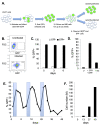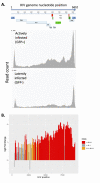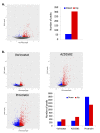Epigenomic characterization of latent HIV infection identifies latency regulating transcription factors
- PMID: 33635929
- PMCID: PMC7946360
- DOI: 10.1371/journal.ppat.1009346
Epigenomic characterization of latent HIV infection identifies latency regulating transcription factors
Abstract
Transcriptional silencing of HIV in CD4 T cells generates a reservoir of latently infected cells that can reseed infection after interruption of therapy. As such, these cells represent the principal barrier to curing HIV infection, but little is known about their characteristics. To further our understanding of the molecular mechanisms of latency, we characterized a primary cell model of HIV latency in which infected cells adopt heterogeneous transcriptional fates. In this model, we observed that latency is a stable, heritable state that is transmitted through cell division. Using Assay of Transposon-Accessible Chromatin sequencing (ATACseq) we found that latently infected cells exhibit greatly reduced proviral accessibility, indicating the presence of chromatin-based structural barriers to viral gene expression. By quantifying the activity of host cell transcription factors, we observe elevated activity of Forkhead and Kruppel-like factor transcription factors (TFs), and reduced activity of AP-1, RUNX and GATA TFs in latently infected cells. Interestingly, latency reversing agents with different mechanisms of action caused distinct patterns of chromatin reopening across the provirus. We observe that binding sites for the chromatin insulator CTCF are highly enriched in the differentially open chromatin of infected CD4 T cells. Furthermore, depletion of CTCF inhibited HIV latency, identifying this factor as playing a key role in the initiation or enforcement of latency. These data indicate that HIV latency develops preferentially in cells with a distinct pattern of TF activity that promotes a closed proviral structure and inhibits viral gene expression. Furthermore, these findings identify CTCF as a novel regulator of HIV latency.
Conflict of interest statement
The authors have declared that no competing interests exist.
Figures








Similar articles
-
A targeted CRISPR screen identifies ETS1 as a regulator of HIV-1 latency.PLoS Pathog. 2025 Apr 8;21(4):e1012467. doi: 10.1371/journal.ppat.1012467. eCollection 2025 Apr. PLoS Pathog. 2025. PMID: 40198713 Free PMC article.
-
Establishment and Reversal of HIV-1 Latency in Naive and Central Memory CD4+ T Cells In Vitro.J Virol. 2016 Aug 26;90(18):8059-73. doi: 10.1128/JVI.00553-16. Print 2016 Sep 15. J Virol. 2016. PMID: 27356901 Free PMC article.
-
BET degraders reveal BRD4 disruption of 7SK and P-TEFb is critical for effective reactivation of latent HIV in CD4+ T-cells.J Virol. 2025 Apr 15;99(4):e0177724. doi: 10.1128/jvi.01777-24. Epub 2025 Mar 11. J Virol. 2025. PMID: 40067013 Free PMC article.
-
Structured treatment interruptions (STI) in chronic unsuppressed HIV infection in adults.Cochrane Database Syst Rev. 2006 Jul 19;2006(3):CD006148. doi: 10.1002/14651858.CD006148. Cochrane Database Syst Rev. 2006. PMID: 16856117 Free PMC article.
-
The intestinal interferon system and specialized enterocytes as putative drivers of HIV latency.Front Immunol. 2025 May 14;16:1589752. doi: 10.3389/fimmu.2025.1589752. eCollection 2025. Front Immunol. 2025. PMID: 40438119 Free PMC article. Review.
Cited by
-
The cell biology of HIV-1 latency and rebound.Retrovirology. 2024 Apr 5;21(1):6. doi: 10.1186/s12977-024-00639-w. Retrovirology. 2024. PMID: 38580979 Free PMC article. Review.
-
Suppression of HIV-1 transcription and latency reversal via ectopic expression of the viral antisense transcript AST.Sci Adv. 2025 May 9;11(19):eadu8014. doi: 10.1126/sciadv.adu8014. Epub 2025 May 9. Sci Adv. 2025. PMID: 40344061 Free PMC article.
-
Advancements in single-cell techniques for examining the HIV reservoir: pathways to a cure.mBio. 2025 Jul 9;16(7):e0065525. doi: 10.1128/mbio.00655-25. Epub 2025 Jun 9. mBio. 2025. PMID: 40488537 Free PMC article. Review.
-
Viral remodeling of the 4D nucleome.Exp Mol Med. 2024 Apr;56(4):799-808. doi: 10.1038/s12276-024-01207-0. Epub 2024 Apr 25. Exp Mol Med. 2024. PMID: 38658699 Free PMC article. Review.
-
A targeted CRISPR screen identifies ETS1 as a regulator of HIV-1 latency.PLoS Pathog. 2025 Apr 8;21(4):e1012467. doi: 10.1371/journal.ppat.1012467. eCollection 2025 Apr. PLoS Pathog. 2025. PMID: 40198713 Free PMC article.
References
-
- Serrano-Villar S, Sainz T, Lee SA, Hunt PW, Sinclair E, Shacklett BL, et al.. HIV-Infected Individuals with Low CD4/CD8 Ratio despite Effective Antiretroviral Therapy Exhibit Altered T Cell Subsets, Heightened CD8+ T Cell Activation, and Increased Risk of Non-AIDS Morbidity and Mortality. PLoS Pathog. 2014;10. 10.1371/journal.ppat.1004078 - DOI - PMC - PubMed
Publication types
MeSH terms
Substances
Grants and funding
LinkOut - more resources
Full Text Sources
Other Literature Sources
Research Materials
Miscellaneous

